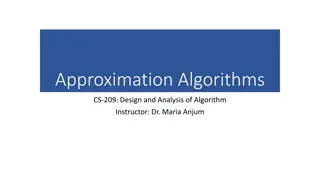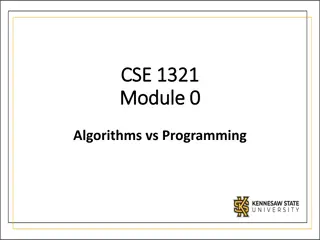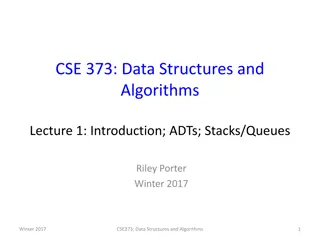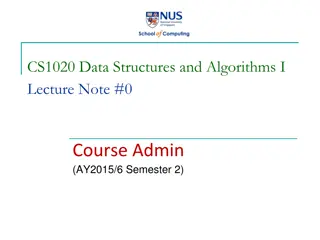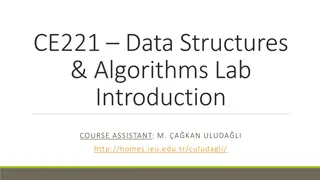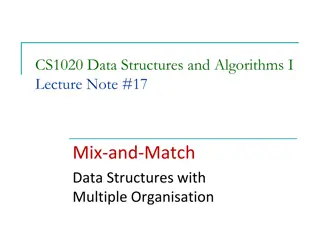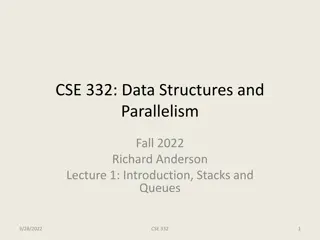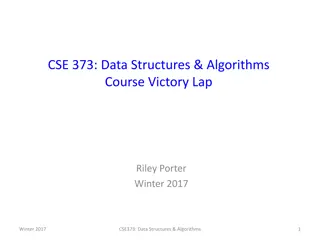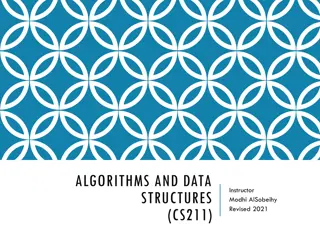Understanding Data Structures and Algorithms in CSE 373
Explore the world of data structures and algorithms in CSE 373 through abstract data types, ADT, list case studies, and practical applications. Dive into concepts such as classes, interfaces, methods, recursion, sorting, generics, and more to understand the core principles of software engineering practices. Discover the basics of data structures, algorithms, and their importance in software development.
Download Presentation

Please find below an Image/Link to download the presentation.
The content on the website is provided AS IS for your information and personal use only. It may not be sold, licensed, or shared on other websites without obtaining consent from the author. Download presentation by click this link. If you encounter any issues during the download, it is possible that the publisher has removed the file from their server.
E N D
Presentation Transcript
Please fill out the Poll at- pollev.com/21sp373 Lecture 2: Abstract Data Types CSE 373: Data Structures and Algorithms 1
Agenda -Dust off data structure cobwebs -Meet the ADT -List Case Study CSE 373 21 SP CHAMPION 2
Announcements Things are live! - course website one stop for all things 373 - Discord connect with students + office hours - Ed board get your course content questions answered - Gradescope HW 0 Assigned Due Wednesday - 143 review - solo assignment CSE 373 SP 18 - KASEY CHAMPION 3
Questions? Clarification on syllabus, General complaining/moaning 4
What is this class about? CSE 143 OBJECT ORIENTED PROGRAMMING CSE 373 DATA STRUCTURES AND ALGORITHMS -Classes and Interfaces -Methods, variables and conditionals -Loops and recursion -Linked lists and binary trees -Sorting and Searching -O(n) analysis -Generics -Design decisions -Design analysis -Implementations of data structures -Debugging and testing -Abstract Data Types -Code Modeling -Complexity Analysis -Software Engineering Practices CSE 373 19 WI - KASEY CHAMPION 5
Data Structures and Algorithms What are they anyway? 6
Basic Definitions Data Structure -A way of organizing and storing data -Examples from CSE 14X: arrays, linked lists, stacks, queues, trees Algorithm -A series of precise instructions to produce to a specific outcome -Examples from CSE 14X: binary search, merge sort, recursive backtracking CSE 373 20 SP CHUN & CHAMPION 7
Review: Clients vs Objects CLIENT CLASSES OBJECT CLASSES A class that is executable, in Java this means it contains a Main method A coded structure that contains data and behavior Start with the data you want to hold, organize the things you want to enable users to do with that data public static void main(String[] args) CSE 143 WI 18 WHITAKER BRAND 8
Abstract Data Types (ADT) Abstract Data Types - An abstract definition for expected operations and behavior - Defines the input and outputs, not the implementations Review: List - a collection storing an ordered sequence of elements - each element is accessible by a 0-based index - a list has a size (number of elements that have been added) - elements can be added to the front, back, or elsewhere - in Java, a list can be represented as an ArrayList object CSE 373 20 SP CHUN & CHAMPION 9
Review: Interfaces Example interface interface: A construct in Java that defines a set of methods that a class promises to implement - Interfaces give you an is-a relationship without code sharing. - A Rectangle object can be treated as a Shape but inherits no code. - Analogous to non-programming idea of roles or certifications: - "I'm certified as a CPA accountant. This assures you I know how to do taxes, audits, and consulting." - "I'm 'certified' as a Shape, because I implement the Shape interface. This assures you I know how to compute my area and perimeter." // Describes features common to all // shapes. public interface Shape { public double area(); public double perimeter(); } public interface name public type public type ... public type } name { name(type name(type typename typename typename typename name, ..., type name, ..., type typename typename name); name); typename name(type typename name, ..., type typename name); CSE 373 20 SP CHUN & CHAMPION 10
Review: Java Collections Java provides some implementations of ADTs for you! ADTs ADTs Data Structures Data Structures Lists Stacks Queues Maps List<Integer> a = new ArrayList<Integer>(); Stack<Character> c = new Stack<Character>(); Queue<String> b = new LinkedList<String>(); Map<String, String> d = new TreeMap<String, String>(); But some data structures you made from scratch why? Linked Lists - LinkedIntList was a collection of ListNode Binary Search Trees SearchTree was a collection of SearchTreeNodes CSE 373 20 SP CHUN & CHAMPION 11
Full Definitions Abstract Data Type (ADT) -A definition for expected operations and behavior -A mathematical description of a collection with a set of supported operations and how they should behave when called upon -Describes what a collection does, not how it does it -Can be expressed as an interface -Examples: List, Map, Set Data Structure -A way of organizing and storing related data points -An object that implements the functionality of a specified ADT -Describes exactly how the collection will perform the required operations -Examples: LinkedIntList, ArrayIntList CSE 373 19 WI - KASEY CHAMPION 12
ADTs well discuss this quarter -List -Set -Map -Stack -Queue -Priority Queue -Graph -Disjoint Set CSE 373 19 SP - KASEY CHAMPION 13
Case Study: The List ADT list: a list: a collection storing an ordered sequence of elements. -Each item is accessible by an index. -A list has a size defined as the number of elements in the list List<String> names = new ArrayList<>(); names.add("Anish"); names.add("Amanda"); names.add(0, "Brian"); CSE 373 SP 18 - KASEY CHAMPION 14
Case Study: The List ADT list: a list: a collection storing an ordered sequence of elements. -Each item is accessible by an index. -A list has a size defined as the number of elements in the list Expected Behavior: Expected Behavior: -get(index): get(index): returns the item at the given index -set(value, index): set(value, index): sets the item at the given index to the given value -append(value): append(value): adds the given item to the end of the list -insert(value, index): insert(value, index): insert the given item at the given index maintaining order -delete(index): delete(index): removes the item at the given index maintaining order -size(): size(): returns the number of elements in the list CSE 373 20 SP CHUN & CHAMPION 15
Case Study: List Implementations ArrayList ArrayList uses an Array as underlying storage LinkedList LinkedList uses nodes as underlying storage List ADT ArrayList<E> LinkedList<E> state state Set of ordered items Count of items state data[] size state Node front size behavior behavior behavior behavior get(index) return item at index set(item, index) replace item at index append(item) add item to end of list insert(item, index) add item at index delete(index) delete item at index size() count of items get return data[index] set data[index] = value append data[size] = value, if out of space grow data insert shift values to make hole at index, data[index] = value, if out of space grow data delete shift following values forward size return size get loop until index, return node s value set loop until index, update node s value append create new node, update next of last node insert create new node, loop until index, update next fields delete loop until index, skip node size return size 0 1 2 3 4 94.4 88.6 26.1 88.6 26.1 94.4 0 0 list free space CSE 373 19 WI - KASEY CHAMPION 16
Implementing ArrayList insert(element, index) with shifting ArrayList<E> 0 1 2 3 insert(10, 0) state data[] size 5 5 3 10 4 4 3 4 numberOfItems = 3 behavior get return data[index] set data[index] = value append data[size] = value, if out of space grow data insert shift values to make hole at index, data[index] = value, if out of space grow data delete shift following values forward size return size delete(index) with shifting 0 1 2 3 4 4 3 3 10 delete(0) 5 5 numberOfItems = 4 3 CSE 373 SP 18 - KASEY CHAMPION 17
Implementing ArrayList append(element) with growth ArrayList<E> 0 1 2 3 append(2) state data[] size 5 3 4 10 behavior numberOfItems = get return data[index] set data[index] = value append data[size] = value, if out of space grow data insert shift values to make hole at index, data[index] = value, if out of space grow data delete shift following values forward size return size 4 5 0 1 2 3 4 5 6 7 2 CSE 373 SP 18 - KASEY CHAMPION 18
Design Decisions For every ADT there are lots of different ways to implement them Based on your situation you should consider: - Memory vs Speed - Generic/Reusability vs Specific/Specialized - One Function vs Another - Robustness vs Performance This class is all about implementing ADTs based on making the right design tradeoffs! > A common topic in interview questions CSE 373 19 WI - KASEY CHAMPION 19





